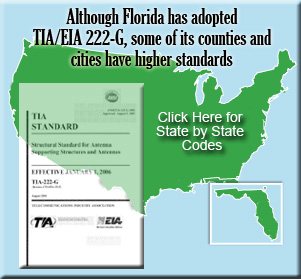|
Revision G is a go in Florida and Ohio, but stalls throughout the nation following IBC adoption
January 1, 2008 - TIA/EIA-222-G, the long-awaited revision of the structural standard for antenna supporting structures and antennas took effect January 1, 2006. Two years later the only states to adopt it are Florida and Ohio.
Since it is a voluntary standard and has no legal bearing, it only gains formidable strength when it's referenced by the International Building Code (IBC) or any other code, and that code is adopted by a permitting jurisdiction.
Unfortunately, Revision G wasn't passed in time to be reviewed and adopted by the IBC 2006 committee and Revision F remained the controlling standard. Last September the publishing of the IBC 2007 supplement made it official, Revision G is now the sanctified standard in the building code bible, but there is an excellent chance that it will not be enforced by some local jurisdictions for years to come, if ever.
Adoption doesn't mandate its use
A number of industry publications and bulletin boards have left the impression that the IBC's adoption now mandates the use of the new revision, but that is not the case throughout the nation (see state by state listing).
Revision G is legally applicable in the State of Florida because the 2004 Florida Building Code was amended December 8, 2006 referencing the newest revision of the standard - not because it was adopted by the IBC.
The 2007 Ohio Building Code, effective July 1, 2007, uses IBC 2006 and did not adopt the IBC 2007 Supplement, however, it has ANSI/TIA-222-G 2005 in its "Referenced Standards".
The code referencing and adoption process is a long, sometimes arduous procedure that can oftentimes take years.
The first IBC Code (2000) was the culmination of an effort that started in 1997 by representatives of Building Officials and Code Administrators International, Inc. (BOCA), International Conference of Building Officials (ICBO) and Southern Building Code Congress International (SBCCI) to have a comprehensive set of unified regulations.
Numerous states such as Arkansas and Indiana are still using IBC 2000 and almost half of all states use IBC 2003.
When California adopts IBC 2006 on January 1, 2008 they will be the one of a dozen states using IBC 2006 statewide. However, Revision F will still be used since it is necessary for states to adopt the IBC 2007 supplement in order for Revision G to be in force, according to Gretchen Hesbacher of the International Code Council.
However, even if a local permitting authority hasn't adopted the IBC 2007 supplement, building officials might require the most current national tower standard, especially if they feel that the standard provides more stringent provisions.
Plans examiners are more familiar with Revision G's newly introduced three second gust wind, the new ice loads, the use of LRFD design procedures, and the seismic provisions that were all included to be more like design requirements that the building codes have for other structures.
Spec writers can include portions or all of Rev G
The entire standard or relevant parts of Revision G can be used as a supplement to a specification that also requires the structure to meet jurisdictional requirements. Purchasers can also request that the tower meet Revision F, if that is the applicable code, as well as Revision G. Whereas the new revision of the tower standard may not currently having legal bearing, it gets all of the strength it needs when the purchaser references it.
Tower manufacturers are currently providing quotes for towers under both F and G revisions when requested. Their engineers are reluctant to discuss how, cost-wise, Revision G is affecting different types of structures, saying that they haven't had the opportunity to develop meaningful data based upon the limited comparisons that have been made.
According to David Brinker of Radian Rohn Products, initial findings show that when both revisions are compared, oftentimes the differences are due to the new 3-second wind not correlating with the old fastest-mile wind speed. In other cases, there is usually a good reason for the differences such as exposure or topographical feature considerations, explained the company's chief engineer and member of the TIA committee that governs the standard.
Engineer Myron Noble of Valmont Industries said that in general, those towers being designed under Revision G are somewhat lighter. However, he noted that Class lll structures (mostly governmental applications) and structures that are on top of hills are quite a bit heavier.
Some towers in Florida analyzed under Revision G, thought to have reserve capacity, experienced unanticipated upgrade requirements when new tenants were added, causing tower owners to reassess their tower assets.
Selecting more stringent design classifications in Revision G will be more expensive, but will also reduce the capacity of existing structures.
Planners for the city of Jacksonville, FL voted to use a Class III structure classification for all towers used in cellular communications, according to Morrison Hershfield. The consulting engineering and management firm said the ruling will adversely impact the structural capacity of cell towers, reducing them by approximately 13% on average.
Class II is the default classification that includes cellular and PCS communications, as well as television and radio broadcasting.
|